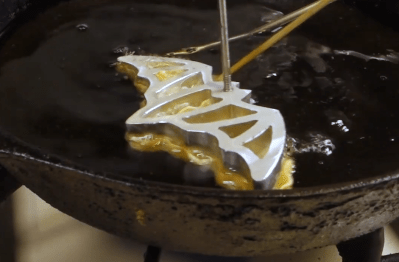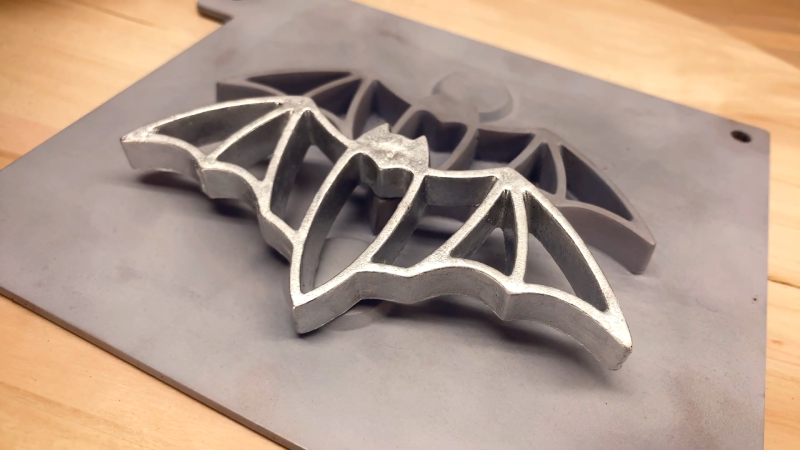As far as the hacker’s toolbox goes, the 3D printer is way up there in terms of utility. Sure, it takes time to learn the ins and outs of designing, slicing, and extruding, but after that, the world is pretty much your additive oyster. Follow those design dreams, or use it to replace the things that break. The icing on the cake? You can chase those dreams into other materials, because 3D prints can be used to cast metal.
 [RetroTech Journal] wanted to fry up some rosette cookies, a Scandinavian delight from his youth that look a lot like fancy, personal funnel cakes. They’re made with special aluminium irons that shape the dough while it fries, as opposed to the jumbled chaos that is funnel cake.
[RetroTech Journal] wanted to fry up some rosette cookies, a Scandinavian delight from his youth that look a lot like fancy, personal funnel cakes. They’re made with special aluminium irons that shape the dough while it fries, as opposed to the jumbled chaos that is funnel cake.
Rosette irons come in a few traditional shapes, but once you get tired of those, it’s up to you to cast them in aluminium. And how would you go about doing that? By creating a firmly-packed sand mold using a mounted 3D print.
In the endlessly entertaining video after the break, [RetroTech Journal] takes you through the entire process from CAD to cookies. It has everything you could possibly want: LEGO stop-motion, claymation, a little bit of cooking, and a whole lot of knowledge. We can’t wait to see what comes next.
We’ve seen quite a few sand casting projects over the years, but this lathe is among the most useful.
















Is there any reason a CNC routed or waterjet cut piece of plate wouldn’t work as a rosette iron? All the ones I can see online specify cast, I’m wondering of that’s down to cost or some other reason?
Perhaps it’s like cast iron skillets where you want the metal to be more porous and absorb oils
I’d guess, but its only a guess that the pitted texture of the cast process gives much greater surface area which keeps the batter where you want it.
Higher finish levels of CNC/waterjet plate surfaces probably won’t work well.
I just cast them because it’s fairly easy/cheap to do. Also I don’t have access to a water jet, or a CNC router. :) There’s no reason they couldn’t be CNC’d. It is important for them to have a bit of a draft angle on there though so you’d need a multi axis water jet to cut them out. Casting is just plain cheaper per-part so if someone were trying to make money selling custom irons, casting would be the way to go.
That depends. If you are going to make a lot of the same thing, perhaps and the way to get to that end would also be different. If you are going to make unique pieces I am not sure casting would be any easier or faster. Casting does not have a 100% success rate.
Thanks for the replies, they make sense. I’ll have a go at CNC cutting one sometime.
So, can you re-use the casting sand? I see some of it looks “burnt” in the video.
BTW, I loved the LEGO stop-action!
There is some casting sand that you can reuse but not sure about all of it.
Generally, quantity: you can produce ten or a hundred castings in one pour, and there is very little metal waste as you can remelt the runners and sprues. Machining from billet means almost all your stock becomes waste.
Also cost. A lot of people cast with natural sand/clay mixtures they’ve dug out of river banks using wooden tooling. You can get into casting for, well, dirt cheap.
Another advantage of casting is that the mold cost is fixed up front. You make one set of molds, and reuse them to make tens of thousands of castings. Eventually they’ll need replacement, but the cost per piece is pennies.
Sand casting is about as cheap as quantity metalworking comes, especially when you don’t have a lot of post-casting machining to do, or stringent finish requirements on the end product.
Cost. Unless you’re only making a small quantity, it will be much cheaper to cast them. CNC time is expensive, waterjet also not cheap. And material costs are going to be higher as well (with lots of unused waste as well).
isnt this how coronavirus got started??!!!
lol. OMG I hadn’t though about that.
Only if the bats are under cooked.
You know how if you keep a sourdough starter, which you have to feed regularly, that now and then you may have more than you can use, well try using it for rosette cookies because the flavour is awesome. And if you haven’t tried that aspect of biohacking yet you should definitely do it because lactobacillus is your friend and fermented foods are one of humanity’s oldest technologies.
In the video section on making the initial form there was one part that was a little confusing, why did he pull off a piece of his beard and rub down the form once it was covered in primer, do wizard beards have magical properties? ;-)
i love this guy’s propane tank.
Ditto!
wheres ozzy when you need him?
I avoid aluminium for food. Bad for brain.
I’ve been eating sandwiches wrapped in aluminium foil my whole life and my brain functions as… as… what time is It?
I am not a neuropsychologist, but my wife is. Continued research has changed most physician’s/nero-professional’s opinions that aluminum causes diseases like Alzheimer’s. I believe Europe still outlaws aluminum cooking vessels (pots/pans/muffin tins/etc.) The US still sells a LOT of aluminum ‘stuff’ (mostly non-stick, or the ‘green pan’ type). I don’t use any aluminum cookware, but it’s mostly b/c I have an induction cooktop.
The early study that connected alumin[i]um with Alzheimer’s was flawed.
The researcher could not afford brain tissues for his study, so he re-used those from an earlier study.
When other researchers were unable to reproduce his results, they investigated his study and found out the Alzheimer’s tissues from the earlier study had been stained with an alumin[i]um based dye.
Thanks for this! I had believed the aluminum-Alzheimer’s link for decades, and was unaware that after being repeated, the studies were essentially inconclusive.
Nope, researchers later discovered that it wasn’t aluminum in the brain that caused Alzheimer’s but rather Alzheimer’s that allowed aluminum into the brain. This has been known for almost 30 years now so why in the world is this stupid myth still going around?
Yeah, bad for brain! That reminds me, I need to stock up on vodka again.
I’ve done a lot of sand casting of 3d printed parts. (If you want to see wizard-level casting skills, including some 3d printing, youtube olfoundryman. He does sand castings that look die cast.) But I’ve moved to lost-PLA casting using plaster or investment, and think it offers a lot of advantages. No draft angle needed, complex shapes with weird interior spaces possible without cores, and you can vacuum or pressure cast to get really amazing detail and low porosity if you want.
3d printing your forms is fantastic, so much easier than wood forms, more precise, and if you do need to split the molds for complex shapes you can do them along arcs or compound curves and still know they’ll match perfectly. If you do need cores, you have perfect support while placing them, and in some cases the mold can serve as the core box.
what a cool instruction video, the slow speed combined with the clear instructions (and subtle jokes) and certainly the stop-motion in between. It all fits very nice together. I loved it from start to end, can’t wait to see more from this channel. Regarding the project, I’m not into baking, but casting things has become more interesting now.
And the funny propane tank really does help.
Great video, fun project, thanks for posting!
You do take the wrap off before eating, do you?
Or perhaps you can’t remember…
;-)
I’m giving this man Wizard level skills for his foundry blower alone
Thanks! I built that blower super cheap out of some black pipe and a BBQ rebuild kit. I used some small copper tubing for the flame keeper. I’d never post a how to about it though because I hacked the fixed regulator to adjust it some, and that is not something I’d ever recommend anyone do. lol.
Cool!
DONT EAT BATS………..Have we learned anything?